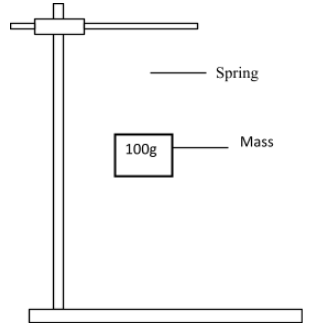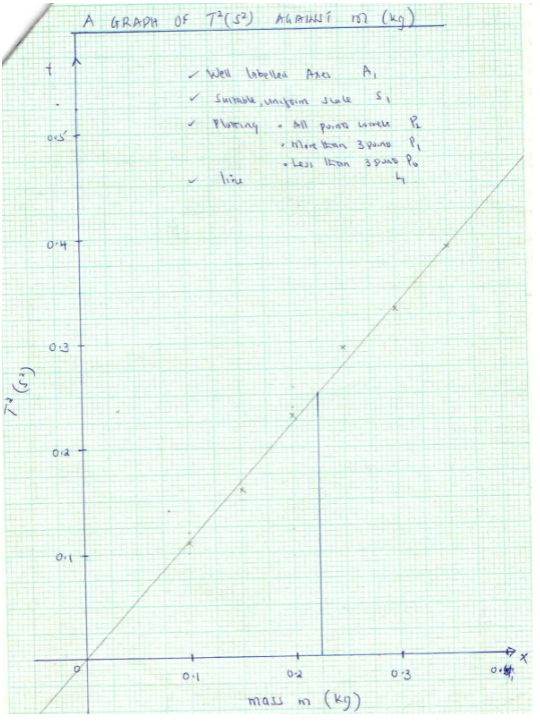INSTRUCTIONS TO CANDIDATES
- Answer ALL the questions
- You are supposed to spend the first 15 minutes of the 2 1/4 hours allowed for this paper reading the whole paper carefully before commencing your work.
- Marks are given for clear record of observations made, their suitability, accuracy and the use made of them.
- Candidates are advised to record their observations as soon as they are made.
- Non-programmable silent electronic calculators and KNEC mathematical table may be used.
QUESTION 1
- You are provided with the following:
- A retort stand, clamp and boss.
- A spiral spring.
- A stop watch.
- Three 100g masses.
- Three 50g masses.
PROCEDURE- Suspend a 100g mass at the end of a spiral spring as shown below.
- Now give the mass a small vertical displacement and release so that it performs vertical oscillation.
- Time for 20 oscillations and determine the period.
Enter the result in the table below. - Repeat the experiment for other values of mass given and complete the table.
6marksMass m(g) 100 150 200 250 300 350 Time for 20 oscillations t (s) Period time T (s) T² (S²) - Plot a graph of T² (S²) (y –axis) against m (kg). (5marks)
- Determine the slope of the graph. (2marks)
- Given that T2=2mwhere k is the spring constant , use the graph to obtain the value of the spring constant k. (2marks)
- Suspend a 100g mass at the end of a spiral spring as shown below.
QUESTION 2.
- You are provided with the following;
- A Complete retort stand
- A Stop watch/stop clock
- A Metre rule
- Two identical springs labeled R and P.
- A Weighing balance (to be shared)
- A Set of masses 10g, 20g, 50g and 100g
- A Pendulum bob
Proceed as follows:
- Join springs R and P in parallel so that it has only one hook at one end and then arrange the apparatus as shown in the figure below.

Note and record the initial pointer reading.
Initial pointer reading = ………………………………………………………….……cm mark.
(This mark should be maintained throughout the experiment) - Hang the 30g mass on the hook of the combined spring balance and record the final pointer reading. Hence calculate the extension, e, for m = 30g.
- With mass, m = 30g, still suspended, slightly displace the mass vertically and time 20 complete oscillations
- Repeat the experiment for m = 50, 70, 100, 120 and 150g and record your results in the table below.
Mass m (g) Extension e (cm) e (m) Time, t, for 20 complete oscillations Periodic time, T (s) T2(s2) 30 50 70 100 120 150 -
- On the grid provided, plot a graph of e(x – axis) against T2 (5 mks)
- Determine the slope, S, of the graph. (2 mks)
- If the experiment obeys the law T = 2π√e/k where k is a constant, determine the value of k (= 3.142) (2 mks
- Weigh and record the mass of the pendulum bob provided.
Mass, m of pendulum bob = ……………..………………..g = ……………………….…….kg (1 mk) - Suspend the pendulum bob on the combined spring balance and note the extension produced.
extension e1= ………………………………….………..cm = ……………………..………..m (1 mk) - If v = mg/e = where m = mass of the pendulum bob and e is the extension produced, find the value of v where v is the elastic constant of the springs. (2 mks)
Marking Scheme
-
Mass m(g) 100 150 200 250 300 350 Time for 20 oscillations t (s) 6.59 8.03 9.60 10.91 11.57 12.56 Period time T (s) 0.3295 0.4015 0.4800 0.5455 0.5785 0.6280 T² (S²) 0.1086 0.1612 0.2304 0.2976 0.3347 0.3944
- For t each correct value ½mk max 3mks
- For T all values correct 2mks more than 3 correct
1mk less than three correct 0mk. max 2mks - For T² all values correct 1mk max 1mk
-
- Gradient = ∆Y = ∆T² = 0.25-0 ✔1 =1.111 s²/kg ✔¹
∆X ∆m 0.225-0 - y = mx +c
T²=π² M+0 =Slope=π²
K K
K= π² ✔ = π² = 8.972N/m ✔
slope 1.11 - Lines P1P2 & P3P4 intersecting at I ✔
- QP0 = 10.0cm✔
Q1= 6.6 cm✔ - n = QP0 = 10.0 = 1.5152✔
QI 6.6 - Refractive index✔
-
- Initial pointer reading = “ Candidates” cm mark
(7mks)Mass m (g) Extension e (cm) e (m) Time, t, for 20 complete oscillations Periodic time, T (s) T2(s2) 30 2.0 2.0 6.63 0.3317 0.11 50 3.2 3.2 8.49 0.4243 0.18 70 6.3 6.3 12.00 0.6 0.36 100 7.5 7.5 12.96 0.6481 0.42 120 9.0 9.0 14.97 0.7483 0.56 150 12 12 16.61 0.8307 0.69 
Labelling- correct quantity + units 1 mark
Scale – simple and uniform 1 mark
Plotting- ½ x 4 2 marks
Line 1 marks
5 marks- S = 0.561 - 0.113
(9.0 - 2.0) x 10-2
= 9.6
Correct internal 1mk
Correct evaluation 1 mk - T= 2π√e/k
T2 = 4π2 e
k
Slope, S = T2 = 4π2
e k
k = 4π2 = 4 x 3.1422
S 9.6
= 4 . 113 2mks - m = 26 g = 0.026 kg
- e=0.42 cm =4.2 x 10-3
- v = mk
0.026 x 4.113
4.2 x 10-3
= 6. 190
Correct substitution
Correct evaluation
- Initial pointer reading = “ Candidates” cm mark
Join our whatsapp group for latest updates
Tap Here to Download for 50/-
Get on WhatsApp for 50/-
Download PHYSICS PAPER 3 Questions and Answers - Form 3 End Term 1 Exams 2023.
Tap Here to Download for 50/-
Get on WhatsApp for 50/-
Why download?
- ✔ To read offline at any time.
- ✔ To Print at your convenience
- ✔ Share Easily with Friends / Students



